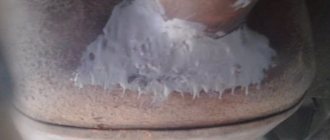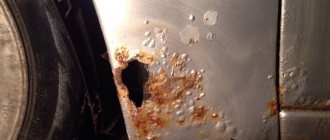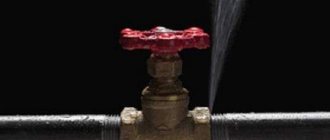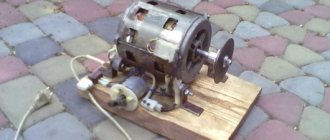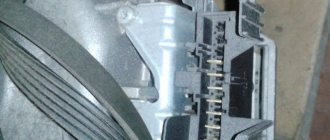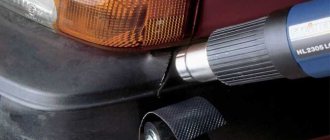The mentality of our people will not allow us to throw away old and unnecessary things. Most thrifty homeowners are jacks of all trades, and they are able to give a second life to any household item. One striking example is an old metal barrel, which many summer residents use for watering their gardens, or as a container for a summer shower.
But time takes its toll, and the longer this barrel lasts, the thinner the thickness of the metal becomes, and, quite possibly, small holes will soon appear that will make further use of the container impossible. Of course, in our time this is not such a big problem; you can also buy plastic containers. Today, stores sell a huge number of different options. But before you spend some money, you can try to breathe new life into an old iron barrel and give it the opportunity to serve for more than one season.
Of course, everyone understands that the service life of metal in the open air is not eternal. Water, sun, wind, acid rain do their job and the metal quickly becomes unusable. And one day you encounter trouble: the barrel has leaked, a small crack or even a through hole has formed. But even an ordinary person, especially a summer resident, is in no hurry to throw a barrel that has become unusable into a landfill and buy a new one. Firstly, you need to invest a lot of money to buy a new container, and secondly, it is quite possible to repair the hole with your own hands.
If the hole is small, you can use cold welding, window putty or all-purpose sealant. Well, if you are faced with a situation where there are many small holes all over the bottom, then you need to use other methods.
What and how to repair a hole in an iron barrel?
- How to seal a small crack?
- How to patch the hole?
- Useful tips
An old metal barrel is an inhabitant of many household plots. It is regularly exposed to aggressive environmental influences - it experiences temperature changes, rain, and sometimes snow. Perhaps it’s time to replace it a long time ago - it’s a little rusty, cracked somewhere, but for that you still need to find a new one. In the meantime, it would be nice to patch up the old one. In this article you can find out exactly how to do this.
How to seal a small crack?
When starting to repair a metal barrel with your own hands, you should:
- determine the acceptable cost of the work;
- how to inspect the damage, what size it is and how critically located it is;
- choosing a method to restore the structure must take into account what is stored in the barrel: to repair a container for drinking water, the products need to be chosen much more carefully; they should not be toxic.
Repairing cracks, crevices and small holes in a metal barrel at home is not so difficult.
Bitumen or a waterproof adhesive such as epoxy resin can help repair the container. They need to cover the crack on the outside of the barrel, fasten a suitable piece of rubberized fabric on them, and go over it again with glue or bitumen.
This is the simplest way to close a small damage.
Cold welding can be used for repairs. It just needs to be used to cover the damaged area that has been previously cleaned with sandpaper or a rust brush and degreased. The main thing is to follow the instructions on the packaging of the composition. For reliability, you can apply the product on both sides. Suitable for small holes and window sealant.
An ordinary chopik (wooden dowel) and silicone sealant will help to repair a barrel with a small hole. The chopik is coated with sealant, driven into the hole, cut to size, and then covered again with sealant on the outside and inside. After 24 hours the container can be used again.
Instead of a chopper, you can close the hole with a suitable size bolt, nut and washer, and put rubber pads on both sides between them and the wall. If you can’t find a washer of the diameter you need, you can make it yourself from sheet metal.
How to bring a leaky barrel back to life: 30 rubles and it’s suitable for storing water
To store large volumes of liquid in a summer cottage, metal water barrels of various sizes are often used. The metal from which they are made can corrode over time, leading not only to leaks through the holes, but also to a significant deterioration in water quality. The appearance of rust can cause sediment on the bottom and plaque on the walls of the container.
To eliminate all of the above problems, you can use one simple but effective method. To seal the hole in the container and restore the seal of the barrel, as well as to maintain the quality of the water, you should purchase plastic bags of the appropriate volume with increased density and a wall thickness of at least 40-50 microns from a hardware or garden store. For example, 220-liter plastic bags are suitable for standard containers, the cost of which is in the range of 30-50 rubles. The package must be carefully inserted into the barrel, placing it inside. The walls of a barrel that has become leaky are first cleaned of sharp edges. To attach the bag to the barrel, you can use an unnecessary rubber hose, which is cut lengthwise and placed on the edge of the barrel. Another option is to seal the polyethylene around the perimeter with tape or tape.
This repair method is temporary and cannot be used permanently. In addition, some large-volume bags are made of plastic that is not suitable for food products, and water from such a barrel cannot be drunk. When purchasing, pay attention to the class of polyethylene and whether it is coated with talcum powder on the inside.
Another budget-friendly method for repairing and restoring the tightness of an old container is to use cold automotive welding, which allows you to pinpoint holes in the bottom and walls. However, this method is only suitable when small holes and cracks appear, which can be closed with a continuous layer of welding. The application technology involves thoroughly drying and degreasing the edges, as well as cleaning them from rust. After carrying out the work, it is imperative to create pressure on the surfaces being treated and wait 24 hours - the period for the mixture to completely harden in order to achieve optimal strength characteristics.
If you have a welding machine and the ability to perform this type of work, small holes and cracks can also be welded.
If the holes in the barrel are too large and cannot be easily repaired, then to use cold welding technology, gluing with epoxy glue or filling with tar, a reinforcing mesh made of special glass or fabric is placed at the bottom of the barrel. As an alternative to tar, you can use liquid rubber, a wide range of which is available in construction stores.
Other methods that suggest filling the bottom of the barrel with plastic or tar may not be economically feasible.
Source
How to patch the hole?
Without welding, you can also repair the leaky bottom of an iron barrel. Most often, the two simplest methods for eliminating such leaks are used.
- Clay. Finding it in the countryside is usually not difficult. So, if there is a leak in a barrel that stands in one place and does not move around the area, you can do the following. In the place where you plan to keep the barrel, you need to dig a hole and fill it 3/4 full with diluted clay. A holey barrel is installed in this hole, and a load is placed on its bottom. All. You don't need to do anything else. Hardened clay will solve the problem with a leaky bottom for a long time.
- Bitumen mastic plus iron sheet. You need to make a patch out of metal that is larger in size than the hole in the bottom. After the patch is installed in place, the bottom is filled with a layer of bitumen one and a half centimeters thick. When the bitumen on the inside has hardened, it is worth covering the outside with mastic. After everything is dry, you can return the barrel to service.
How to seal a plastic tank or water barrel - choosing an epoxy discount
If the defect in the plastic container is small, you can use epoxy glue. Two-component epoxy adhesive will help effectively solve the problem of a leaky plastic tank.
It is characterized by increased resistance to moisture and chemicals, polymerizes in just 1 hour, and is non-flammable.
It is necessary to cut off the required amount of glue, knead it with clean hands until a homogeneous mass is obtained, fashion a cone out of it and insert it into the hole in the tank. Fix securely for a few minutes.
Then you need to wait 2 hours, after which the container can be used.
Epoxy glue-plasticine Contact has proven itself well. Can be used directly under water, resistant to moisture.
Useful tips
The first thing you should remember when starting to repair an old barrel: using a welding machine to eliminate a hole, regardless of its operating principle, is pointless. The walls of the tank are thin, damaged by time and corrosion, welding will only add new holes to the old ones. Another little subtlety: if you don’t want to bother with bitumen, then when repairing small holes it can be replaced with liquid plastic. You can find this composition at a hardware store.
You can do something clever - instead of repairing a rusty barrel, make it not the main container for water, but only an integral part of the structure. Here you should adhere to a certain plan of action.
- Get the most dense and voluminous plastic bags, larger than the volume of the barrel itself, tape, a wire brush and aluminum wire.
- Use a brush to clean the inside of the barrel from any irregularities so as not to tear the polyethylene.
- Place one bag inside the other, align them and release any air that has accumulated between the bags.
- Secure the edges of the bags together with tape. It is worth gluing every 10–15 cm of the top edge, leaving space for air to escape so that the bags do not burst.
- Make a hook (10–15 cm) from wire (suitable diameter - 5 mm) and fasten it to the barrel so that the upper edge of the wire moves upward from the edge of the barrel by 5 cm. Bend the wire inside the barrel and press it against the wall.
- Place the bag into the barrel, bending the top edge outward 10–15 cm around the entire perimeter of the barrel.
- Firmly tape the bag allowance to the outside of the barrel. You cannot cover the outer end of the hook; it is better to glue it higher. The hook will create an additional path for air to escape.
- Ready! The barrel can be used further.
And finally, a few simple but important recommendations:
- after most repair options, the barrel will become unsuitable for storing drinking water, remember this;
- before carrying out any manipulations, it is necessary to clean the area you are working with from rust - the glue may simply not set if this is not done;
- follow the instructions when working with glue, sealant or liquid plastic - this will save your nerves, money and time;
- Be careful, act carefully and, perhaps, the barrel will serve you for more than one season.
For information on repairing an iron barrel, watch the video below.
A hole is definitely not a death sentence: we give the barrel a second life
Reading time: 3 minutes No time?
Water is a very valuable and necessary resource, especially for summer residents and owners of personal plots. You need a lot of it: for drinking, washing dishes, washing and watering. Water needs to be stored somewhere, but not everyone can build a well or buy a large metal container. For these purposes, many people use two-hundred-liter iron barrels of petroleum products, which break down over time. However, do not rush to throw away a container with holes. In today's HouseChief editorial review, we'll talk about how to give an old barrel with cracks and holes a second life.
Read in the article
Soldering polypropylene (PPR)
Almost everything has been said about soldering PPR pipes, but few people know about soldering during a leak. If it happens that water is oozing from the pipe, it will not be possible to solder it properly. To do this quickly, without waiting for the water to completely drain, insert mashed bread into the pipe - as much as will fit. Then, working quickly and accurately, you should solder the ball valve in the standard way. While the bread is soaking from the water, the soldering will have cooled down. Then the loose plug will be washed out by the pressure of water.
The following methods are only suitable if the leak has completely stopped.
Source
Using plastic bags
A hole in a metal barrel is not a reason to throw it away. The container can still be used for many years thanks to one fairly simple means - plastic bags. This is not only the easiest, but also the most inexpensive option for restoring a leaky container. To do this, you will need to purchase garbage bags with a volume of about 240 liters and a density of at least 60 microns at a hardware or hardware store. It is necessary that the polyethylene product exceeds the capacity in volume and perimeter. The package may be larger than the barrel, but it is also allowed to be smaller, but not more than 20-30 mm, since polyethylene tends to stretch. As a result, the water will be stored in dense polyethylene, and the barrel structure serves as support for it.
It is worth knowing that it is not enough to insert a plastic bag into a barrel and continue to use the container. There are several nuances that must be taken into account for this method to work properly.
Puncture prevention
Polyethylene is still not metal and can tear, no matter how dense it is. Therefore, it is necessary to prepare the barrel for reuse. The inner surface of the metal container must be cleaned of rust, loose hard pieces of paint and burrs that could damage the bag. It is better to treat the barrel with a metal brush. When cleaning, check the surface of the container with your palm, and if there are no more sharp areas, you can stop processing. There is no need to paint the inside of the barrel.
The barrel must be cleaned of sharp edges
After cleaning the inner surface of the barrel or instead of it, you can play it safe and use cardboard or plastic. First you need to cut out a circle corresponding to the inner diameter of the container, and a rectangle in which one side corresponds to the height of the barrel, and the other to its perimeter. This way you can be sure that sharp edges from a hole or crack will not damage the plastic bag.
Two is always better than one
To be sure of the integrity of the restored container, it is better to use two bags at the same time. It is necessary to insert them one into another so that their corners on the sealed side completely coincide. Next, lay them out on a flat surface and smooth them from the bottom to the neck, thus expelling the air. You won't be able to get rid of it completely, but that's not a big deal.
Now you need to align the edges of the neck and fasten the bags together around the perimeter with tape at a distance of 100-150 mm from each other. Place the resulting double bag into the barrel, bending the edges of the sleeve (50-150 mm) onto the outer surface of the metal container. Do not allow the bags to be suspended, otherwise they will burst under the weight of the water. To prevent the wrapped edge from sliding back into the container, it is necessary to secure it with wide tape on the outer surface of the barrel along the entire perimeter.
It is advisable to choose a large bag so that the bend is more than 150 mm, and secure it with tape around the perimeter
Advantages of using polyethylene
When using bags to restore a metal container, water will be saved throughout the entire summer season and will remain clean and free of rust. Such water can be used not only for irrigation, but also for washing and primary processing of vegetables. In winter, it is recommended to remove the bags, dry them and store them folded in a warm place. Polyethylene is lightweight, takes up little space and, thanks to its properties, can last another 1-2 seasons. The same goes for the barrels themselves. If you want them to serve you for many years, at the end of the season they need to be emptied, dried and stored in a dry shed.
Thanks to the use of polyethylene, there will be no rust in the water
We use a bag to extend the life of the barrel
In the store I bought plastic garbage bags - 60 microns, volume 240 liters. It is very important that the volume of the bag is significantly larger than the volume of the barrel, and its perimeter is equal to the perimeter of its outer cylindrical surface (if more, this is welcome; if less, then no more than 2-3 cm - polyethylene is elastic and stretches a little). I think you guessed it: the water will be stored in a bag, and the barrel should only serve as a supporting frame for it.
At first I wanted to finish writing here, but after thinking about it, I decided: no, I need to convey some nuances, then you will save both time and nervous energy. The technology is simple.
Repairing a crack in a water tank
As we have already said, the use of plastic bags is the simplest and most cost-effective option for restoring a leaky container. But he's not the only one. Let's look at how else you can eliminate a leak in a metal barrel.
The defective area on the outer surface of the barrel wall must be treated with special glue or bitumen. Next, a piece of fiberglass or rubberized fabric is applied, larger in size than the existing crack. The patch needs to be well tarred or glued on top again. For greater reliability, the crack on the inner surface of the barrel must be cleaned of rust or paint and also treated with resin or glue.
Patch made of fiberglass and glue
If a crack appears in the bottom of the barrel, it can be repaired using clay mortar. To do this, in the place where the container will be installed, you need to dig a small hole, slightly larger than the diameter of the barrel, and fill it with liquid clay. After this, immerse the empty container in the solution. When the clay dries, a fairly dense crust forms, through which liquid practically does not seep through. This method will give the cracked barrel a few more years of life.
How to get rid of a leak in a pipe
If a fistula is detected in the pipeline, it is necessary to immediately begin to prevent the leak. To do this, we suggest using one of the options:
Installation of clamp connection
The most common method of repairing cracks in a pipe is a clamp connection. The specialized device consists of the following connecting elements:
To install the clamp yourself, follow these steps:
Application of a bandage element
If you don’t have a clamp at hand, in this case, leaks on the pipe surface can be eliminated by using a bandage. It comes in several types: rubber, glue or cement.
Rubber bandage
Adhesive bandage
Cement bandage
The steps are similar to those with glue. Prepare a semi-liquid composition from cement in an equivalence of 1:10. Soak fiberglass or a piece of gauze in it and wrap it around the pipe.
On a note! If you don’t have special glue at home, you can replace it with epoxy resin. If there is a crack in an iron pipe, then you can use the most common table salt.
Cold welding
This technique can be classified as a new technology. After all, to eliminate a leak, all you need to do is apply a special compound to the crack site - cold welding. It is suitable for repairing pipes made of metal, plastic, metal-plastic. The compositions of cold welding are also different.
Below we will consider a general analogue of using the mixture. The same instructions are printed on the bottle itself.
How to repair a hole in a metal barrel
In addition to bags made of thick polyethylene, there are two other available ways to seal a small hole in a garden barrel. For one of them you will need a bolt with a nut, two washers of the appropriate diameter and sheet rubber. Rubber gaskets and washers are placed on the hole in the wall of the container on both sides, after which the bolt is threaded, and this kind of patch is clamped well with a nut.
A simple solution to fix a leak - a bolt with a nut, washers and rubber gaskets
If a large hole has formed in the barrel, then you need to take a large diameter bolt and cut washers from sheet metal. Raw rubber is ideal for gaskets as it provides a good seal. It is best to warm it up before gluing it, or carry out work in a warm room.
Minor holes in the barrel can also be sealed using “cold welding”. This is a two-component composition that has excellent sealing characteristics and high adhesion to any well-cleaned surface. “Cold welding” is an excellent solution for eliminating small cracks in a barrel. But for greater guarantee, they should be processed both from the outside and from the inside of the container.
Closing a hole with “cold welding”
Recommendation! Repairing a metal water barrel at the dacha using gas and electric welding is a pointless exercise. The fact is that the walls of the container are quite thin and, in the end, they will simply burn out, there will be more holes, and the barrel can simply be thrown away.
Cold Welding Selection
When choosing, many people have a question whether cold welding produces current. If you are selecting a substance for working with stainless steel, then you should choose brands that contain the appropriate filler. Due to the presence of filler, the substance conducts electric current. In other cases, when cold welding does not contain a filler, it does not conduct current.
It is worth paying attention to the temperature limit within which the composition can operate. Metal parts that require repair often operate at elevated temperatures and this parameter can be quite important. For many cases, drying speed is important, since in the case of an emergency repair there may not be time to wait several hours. For frequent repairs, it is best to take large-capacity packaging, as they are more economical.
We invite you to familiarize yourself with Sunflower on the windowsill
How to seal holes in a metal tank if there is no welding?
Content:
- Methods for waterproofing a metal tank
- Iron barrel repair
- Properties of putty
There are situations in life when you need to repair a hole in a metal tank, but you don’t have welding tools at hand. What to do in such cases? It would be logical to contact a specialized craftsman, that is, a welder. But, if you live far from the city in a small village where there are no such masters. Or you need to call a specialist from the city, but this is expensive and unprofitable. So how can you seal holes in a metal tank if there is no welding? In this article we will talk about several simple ways to solve this small problem. Most often, holes in metal containers are formed due to corrosion, rust and old age. Of course, you can solve the problem by replacing the old tank with a new one. But, if a small hole appears in one place, and overall the container is in good condition, why overpay. Thanks to modern materials, you can seal the hole in the tank yourself.
Required Tools
Before starting work, be sure to ensure that you have:
- an adjustable wrench (it should be larger than the largest nut in the boiler);
- electronic tester;
- set of tubular keys;
- rubber hose for draining water from the tank;
- socket wrenches;
- screwdriver;
- knife.
If you don’t have something from the list, then be sure to buy this tool, especially since it may come in handy in the future.
Some people believe that with minimal knowledge of how the boiler works, they can easily install or repair it. In fact, minimal knowledge is not enough; full-fledged repairs should be carried out by specialists. But if we are talking about a boiler leak, it is quite possible to deal with it on your own.
You may be interested in information about where the air in the boiler comes from.
Methods for waterproofing a metal tank
If you don’t have a welding machine, there are several other options to solve this problem. Surely many people at their summer cottage use metal and plastic barrels and tanks. This equipment is indispensable, especially for gardeners. Over time, any metal container can develop cracks and holes. You should not immediately throw away such a tank; you can repair it using:
- “cold welding” method (can be bought in a specialized store, sold as glue, putty or rod. Instructions for use are included with this product);
hot glue gun (price in the store from 400 rubles. With the help of molten plastic and instructions you can figure out how to seal the hole in the tank. This repair is suitable for containers in which you store only cold water);
clamps (place rubber on the damaged wall of the tank, attach and tighten it with a clamp. When a hole appears at the bottom, a flat metal cover with holes for bolts must be placed on the rubber);
wooden chopper (you need to cut a cone-shaped figure from wood according to the diameter of the hole and hammer it into the hole half its length with a hammer);
welding pencil (clean the edges of the hole from the inside, cut out a metal or tin patch and solder it).
A few words in conclusion
A hole or crack in a metal water barrel is not a death sentence. Using the tips above, you can easily give the container a second life. As a last resort, if the barrel cannot be revived, it can always be used as a garbage container. If our information was useful to you, please rate the article and express your opinion in the comment form. Or maybe you have your own options for barrel repair? Share your experience with us.
Barrels made of plastic and metal are one of the most useful tools in a summer cottage. Gardeners know many ways to use containers, and it’s even more offensive when a hole appears in the side or bottom. You shouldn’t immediately throw away your equipment; there are several options for renovation and repair, as well as using leaky barrels to leave the container to serve for another 20 years.
Iron barrel repair
You can revive the container using the above methods. But, there are even simpler and cheaper methods for repairing barrels. You can seal the hole with improvised means that you have at your dacha. To save the container you can:
- glue it (this is like gluing a damaged car tire. First, dry the damaged area, get rid of the rust, then you need to cut out a piece of rubber and seal the hole with glue. You can fill the hole inside with garden pitch);
tar (clean the hole from rust, apply resin, stick a thick piece of fabric on it and apply an additional resin layer outside and inside);
seal with clay (you need to immerse the bottom of the barrel in the clay mixture and wait for the layer to dry completely. You can also try foaming the hole in the tank for water, so water will not flow out of the container either).
Experts do not recommend using a welding machine to seal holes in metal containers. The walls in a barrel or tank are not so strong and they will not be able to withstand the welding temperature, so you will make even more holes. Nowadays, many people use special putties to seal cracks and holes, which can be bought at any hardware store. Putty is a viscous dough-like mixture that adheres tightly to the surface of an object and becomes hard and durable over time. This mixture is used to eliminate crevices, holes, cracks and depressions. The composition of putties can be different and the choice of this mixture will depend on the material of the parts that need to be joined.
How to seal a plastic container
Is it even possible to seal a plastic container or gas tank?
How to seal a plastic container? Nowadays, there are many invented ways to weld cracks, holes, burst seams, the equipment for such repairs is also varied, from a soldering iron to a hair dryer, whatever you need. It can be repaired with such tools, but where is the guarantee that it will not leak again. Such repairs will be simply decorative and the owner will incur new expenses in the future. Requires knowledge of the material and practice. Our craftsmen use professional equipment from a well-known Swiss company and provide a guarantee on the repaired container, tank, tank, or gas tank made of plastic.
Plastic containers are made mainly from materials such as polyethylene and polypropylene; it is almost impossible to glue anything to these materials due to their chemical characteristics, and trying to seal a container made of these materials is a waste of time. For large volumes of plastic containers of 2 cubic meters or more, this type of repair will not help at all; in this case, only welding with special equipment will ensure the container is sealed!
Properties of putty
Using this product, you can seal cracks in cast iron parts that are not heated to temperatures above 300 degrees, as well as objects that are not heated above 700-800 C. The putty is often purchased to repair cracks and crevices on iron, glass, metal and even a stone. This is how you can seal a metal water tank without difficulty and at minimal cost. High-quality mixtures have the following distinctive properties:
high adhesion density to materials;
resistance to external factors.
To get maximum results when using putties, you need to use them correctly.
Before applying the mixture, the surface must be prepared, namely, thoroughly clean grease, oil, oxides and dust. It is necessary to apply the finished mass not in a thick layer and using a special spatula. The market also sells putties that are used for high temperatures. They contain fireclay, iron filings, manganese peroxide, table salt and other components. Now you can see for yourself that there are many options for repairing a hole in a metal tank without welding.
Didn't find the answer to your question? - Ask it to an expert!
Brands and their technical characteristics
Weicon - available in 57 and 117 gram packs. The operating temperature range is from -40 degrees to 280. It can withstand temperatures of 300 degrees for a short time. The processing temperature ranges from 10 to 30.
We invite you to familiarize yourself with the lifestyle of a mosquito and its role in nature
Contact - consists of two components in the form of plasticine bars, which includes a resin and a hardener. The gluing seam can withstand temperatures from -40 to 150 degrees Celsius. After gluing, the seam can be machined.
Diamond – comes in a 58 gram package. 90% of the composition dries within 15 minutes after use. It may take about 3 hours to completely cure, depending on the ambient temperature. Packaging storage temperature from 5 to 30 degrees Celsius
ASBRO – supplied in a 57 gram package. It takes a little longer to dry, since the initial setting occurs within 1 hour, and the final setting, approximately, within a day. The mixture must be prepared at a temperature of 10 to 25 degrees Celsius.
How to repair a hole or crack in an old iron barrel without welding
The mentality of our people will not allow us to throw away old and unnecessary things. Most thrifty homeowners are jacks of all trades, and they are able to give a second life to any household item. One striking example is an old metal barrel, which many summer residents use for watering their gardens, or as a container for a summer shower.
But time takes its toll, and the longer this barrel lasts, the thinner the thickness of the metal becomes, and, quite possibly, small holes will soon appear that will make further use of the container impossible. Of course, in our time this is not such a big problem; you can also buy plastic containers. Today, stores sell a huge number of different options. But before you spend some money, you can try to breathe new life into an old iron barrel and give it the opportunity to serve for more than one season.
Of course, everyone understands that the service life of metal in the open air is not eternal. Water, sun, wind, acid rain do their job and the metal quickly becomes unusable. And one day you encounter trouble: the barrel has leaked, a small crack or even a through hole has formed. But even an ordinary person, especially a summer resident, is in no hurry to throw a barrel that has become unusable into a landfill and buy a new one. Firstly, you need to invest a lot of money to buy a new container, and secondly, it is quite possible to repair the hole with your own hands.
If the hole is small, you can use cold welding, window putty or all-purpose sealant. Well, if you are faced with a situation where there are many small holes all over the bottom, then you need to use other methods.
- Closing the crack
- Seal the hole Seal the hole with rubber
- Survey
- Let's resin the hole
- Plastic bags
- Without bottom and “tire”
Restoring a barrel using cellophane
When small holes form, they are sealed with cold welding or universal sealant or window putty. When holes form, cellophane is used.
Procedure:
- Take a strip of thick cellophane, preferably in the form of a pipe. Cut the piece to the height of the barrel with an allowance.
- Fold one edge of the film, put newspaper under it and also line the cellophane with newspaper on top.
- Heat the iron, melt the edges so as not to burn holes in the film.
- Cool the cellophane, remove the newspaper and straighten the film - the pipe makes an excellent bag that is inserted into the barrel.
- First, test the bag for the tightness of the joint - pour a little water, if it does not leak, then you can insert it. There are holes, cut off the welded edges and repeat the gluing procedure with an iron again.
When placing the bag in a container, you need to spread the cellophane as tightly as possible along the walls so that there are no wrinkles left. Use it for any purpose, but when taking water from the container with a bucket, you need to be careful not to tear it.
Closing the crack
If cracks or holes appear in the bottom or side walls of the barrel, they can be repaired in several ways. It is necessary to coat the crack on the outside with melted resin or waterproof glue. Then you will need rubberized fabric or fiberglass, which is used in construction work. We place a small piece on the molten resin, and coat it with another layer of resin or glue on top. To make the patch more reliable, exactly the same operation is performed on the inside of the barrel, but before that the area being repaired must be thoroughly cleaned of rust.
The leaky bottom of a metal barrel can be sealed with clay diluted in water. To do this, in the place where the container is expected to stand, you need to dig a small pit, which is subsequently filled with clay (you can knead the clay directly in this pit). After this, we install the barrel in the pit and place some weight inside so that the barrel fits tightly into the pit. Once the clay dries, it forms a durable layer through which water will no longer seep through. Having installed the barrel in this way, you will be able to use it for many more years.
Fixing a leak in a heating pipe
A leak in a heating pipe can occur for several reasons:
To eliminate such problems in heating pipes, several options are used to get rid of the leak: use glue, cold welding, or install a clamp.
If through rust has formed in the pipe, then cold welding or an adhesive mixture is unlikely to help. In this case, you will have to replace the corroded section with a new pipe.
Preparing the “stub”
Electrode welding is not often used when repairing a crack in a heating pipe. And in winter it is difficult to do this. You might suggest using a so-called “stub”. To prepare it, take a piece of old material, impregnate it with sealant, and then wrap it around the required area.
Before attaching the “plug”, water should be drained from the heating system. Dry the leaking section of the pipe, clean it from dirt and dust. Only after careful preparation can you begin to repair the crack.
You can use old burlap or a medical bandage as material for the “plug”. For the adhesive base, use liquid glass or a silicone hermetic mixture used in construction.
Repairing the crack is simple. First of all, soak the material in the hermetic mixture. Use a brush to brush over the surface of the heating pipe. Wrap the pipe with a cloth soaked in sealant and leave the composition to harden for a while.
If the crack or hole is small, then you can use plasticine sealant. In order for it to tightly close the leak, the composition must be mixed with a hardener. Apply the product to a dry and thoroughly cleaned surface of the pipeline. Once the sealant cures well, it will become rock hard.
It will be interesting: Step-by-step connection of a water heater with your own hands
Closing the hole
The fastest and most common option for repairing a barrel and more is to use a bolt with a nut and washers of suitable sizes. Take the bolt, put a metal washer on it first, then a rubber one. Next, insert the bolt with washers into the hole, and perform exactly the same operation on the reverse side. This entire structure is tightened with a nut, and the hole is reliably sealed.
In this case, you can use raw rubber as a gasket, which is used for vulcanizing car inner tubes; it is this that can provide excellent sealing. Cold weld putty can be used to seal small holes. This putty is a two-component composition and is characterized by a high degree of adhesion to any cleaned surfaces. Cold welding can also be used to seal small cracks. For greater reliability, the crack must be treated on both sides.
It is not recommended to use an electric or gas welding machine in this situation to apply a metal patch. The wall of the barrel is very thin, so it will simply burn out, and there is a high probability that there will be even more holes.
Seal the hole with rubber
A worn-out metal container can be made suitable for further use by simply sealing it, like a car inner tube. A leaking metal barrel is emptied of water and dried in the sun. Next, you need to clean off the rust from the outside using sandpaper or a wire brush. This must be done carefully so that the hole does not become even larger. Then take an old car or bicycle tube, cut out a piece slightly larger than the hole in the barrel, and glue it with Moment glue. You can use any other waterproof glue. For greater reliability, the hole on the inside can be covered with garden varnish to stabilize the water pressure.
Survey
Let's resin the hole
But if the hole is too large or there are several of them, then it is better to tar the barrel. To do this, you first need to clean off all the rust with a wire brush, and then apply a layer of hot resin in place of the holes. A layer of durable material is applied to the resin that has not yet cooled down, then another layer of resin is applied. The heated resin has a viscous consistency and adheres well to the iron. To prevent cracking of the dried resin, several layers of paint can be applied on top.
Plastic bags
Another method for repairing a metal barrel is to use plastic garbage bags. The largest packet size is taken. As a rule, such bags have a thickness of up to 60 Microns and a volume of over 240 liters. The volume is very important because it must be significantly larger than the volume of the barrel, and the circumference of the garbage bag must match the circumference of the barrel. Then the bag is placed on the bottom of the barrel, pressed tightly against the sides, the top edge of the bag is wrapped on the barrel and glued with tape. It’s even better to use two bags for this purpose, inserting them one into the other. The essence of this method is very simple, the water will be stored in a bag, and the barrel will act as a supporting frame for it.
Without bottom and “tire”
If, nevertheless, you were unable to save the metal barrel, do not despair, it can be successfully used as a stove for burning garbage in the garden. As an addition, you can make a metal grate by making it from a steel rod with a diameter of 8 - 10 millimeters. Prepare a platform, install brick pillars on it, place a grate on them, and place a barrel on the grate. Then everything is simple, pour the garbage into the barrel, and make a fire below under the grate. The natural draft that will be present in this case will allow you to burn any garbage, even green juicy grass, in an improvised stove. Naturally, over time the bottom of the barrel will burn out. You just need to turn it over, and it will serve as a stove for some time.
If you have a plastic barrel in your garden, and somehow holes have formed in it, then they can be repaired using silicone glue and sealant. To do this, the hole area must be thoroughly degreased, then a layer of sealant must be applied. After it dries, the repair area will look like a welded patch.
Bronze is an alloy of which metals
Bronze is an alloy based on copper. Auxiliary metals can be nickel, zinc, tin, aluminum and others. In this article we will look at the types, technological characteristics, chemicals. composition of bronze, as well as methods of its production.
Classification
1. Based on its chemical composition, this metal is usually divided into two groups. The first is tin bronzes. In them, tin is the main alloying element. The second is tin-free. Below we will talk about this in more detail.
2. Based on technological characteristics, bronzes are usually divided into wrought and cast bronzes. The former are well processed under pressure. The latter are used for shaped castings.
Compared to brass, this metal has much better anti-friction and mechanical properties, as well as corrosion resistance. In fact, bronze is an alloy of copper and tin (as the main auxiliary element). Nickel and zinc are not the main alloying elements here; for this purpose, components such as aluminum, tin, manganese, silicon, lead, iron, beryllium, chromium, phosphorus, magnesium, zirconium and others are used.
Let's figure out what this metal is. Tin bronze (the photo below shows cast parts) is an alloy whose fluidity is lower than other types. However, it has insignificant volumetric shrinkage, which makes it possible to obtain shaped bronze castings. These properties determine the active use of bronze in the casting of antifriction parts.
The alloy in question is also used in the manufacture of fittings intended for use in an aquatic environment (including sea water) or in water vapor, in oils and under high pressure. There are also so-called non-standard casting bronzes for critical purposes. They are used in the production of bearings, gears, bushings, pump parts, and low-seal rings.
Such parts are designed to work under high pressure conditions, at high speeds and low loads.
This subtype of cast tin alloys is used in the manufacture of bearings, oil seals and shaped castings. Such bronzes are characterized by low mechanical properties, as a result of which, in the process of manufacturing bearings and bushings, they are simply applied to a steel base in the form of a very thin layer. Alloys with a higher tin content have higher mechanical properties. Therefore they can be used without a steel base.
Tin bronzes: deformable
Alloys processed by pressure are usually divided into the following groups: tin-phosphorus, tin-zinc and tin-zinc-lead. They have found their application in the pulp and paper industry (they are used to make meshes) and mechanical engineering (the production of springs, bearings and machine parts).
In addition, these materials are used in the manufacture of bimetallic products, rods, strips, strips, gears, gears, bushings and gaskets of highly loaded machines, instrument tubes, and pressure springs. In electrical engineering, the widespread use of bronze (deformable) is explained by its excellent mechanical properties (along with high electrical characteristics). It is used in the manufacture of current-carrying springs, plug connectors, and contacts.
In the chemical industry, tin bronzes are used to produce spring wire, in precision mechanics - fittings, in the paper industry - scrapers, in the automotive and autotractor industries - bushings and bearings.
These alloys can be supplied in extra-hard, hard, semi-hard and soft (annealed) states. Tin bronzes are usually processed cold (by rolling or drawing). Hot metal is only subjected to pressing. Under pressure, bronze is perfectly processed both cold and hot.
Beryllium bronze
This is an alloy belonging to the group of dispersion-hardening metals. It has high mechanical, physical and elastic properties. Beryllium bronze has a high level of heat resistance, corrosion resistance and cyclic strength. It is resistant to low temperatures, does not magnetize and does not produce sparks upon impact. Hardening of beryllium bronzes is carried out at temperatures of 750-790 degrees Celsius.
The addition of cobalt, iron and nickel helps slow down the rate of phase transformations during heat treatment, which significantly facilitates the aging and hardening technology. In addition, the addition of nickel helps to increase the recrystallization temperature, and manganese can replace, albeit not fully, expensive beryllium.
The above characteristics of bronze allow this alloy to be used in the manufacture of springs, spring parts, and membranes in the watch industry.


